If you want your plants to survive our changing climate, know their wild habitat

The harsh, hot summer has changed things: we will have to garden differently from now on. Capitalism has seduced us in the garden as it has elsewhere – we’ve been lured by pretty things and imagine we can have whatever we want. But plants are not paint and gardening is not decorating: it’s about creating an ecosystem for humans and non-humans alike.
The right plant, right place mantra is not new – gardeners have said it for years. It means knowing your soil and the plant’s soil needs; they must align if our gardens are to survive wildly varying weather patterns, from wetter winters to baked-out summers. A good starting point is the soilscapes map . A search by postcode brings a detailed account of local soils, water table and drainage. Your garden may differ depending on how much soil improvement you have done, but it won’t be far off the mark.
The cropping advice offered is for farmers, but the soil type, texture and habitat advice are all invaluable. If it says your soil is clayey, no amount of wishful thinking about wanting to introduce dry garden plants is going to change that. In winter it will be wet and will rot the roots of plants that hail from free-draining, rocky and stony places.
If your ornamental garden plants look thirsty, that’s because they are most likely streamside species
The drought tolerance of any plant is predictable by their wild habitat. If your ornamental garden plants are looking a little crisp-edged and thirsty, that’s because they are most likely streamside, damp woodland species.
For example, most herbaceous anemones, the many and various crosses of the Japanese anemone – Anemone hupehensis, A. tomentosa, A. vitifolia and A. x hybrida – are found largely in China and naturalised in Japan, in damp, open woodlands, scrubland and streamsides.
All these habitats have some sort of partial shade and soil that is, well, damp. If you grow them in full sun all day long, or in exposed windy sites, you will have crispy leaves in hot summers, even in soil that, deep down, retains some moisture. Partial shade really means afternoon shade – from a building as much as a tree or shrub. The same goes for summer phlox, Phlox paniculata, many lobelias, polygonums, irises, astilbes and ferns: in nature they grow by streamsides with dappled light. In years gone by, they might have thrived in full sun because the summer brought more drizzle, but not so now.
It is not always easy to find information on a plant’s wild habitat; it’s missing from most plant labels and even books, but the internet will get you there. Search the Latin name plus wild growing conditions and habitat, and be prepared to hunt past the first page, which is largely all shopping.

 Yahoo News
Yahoo News 
